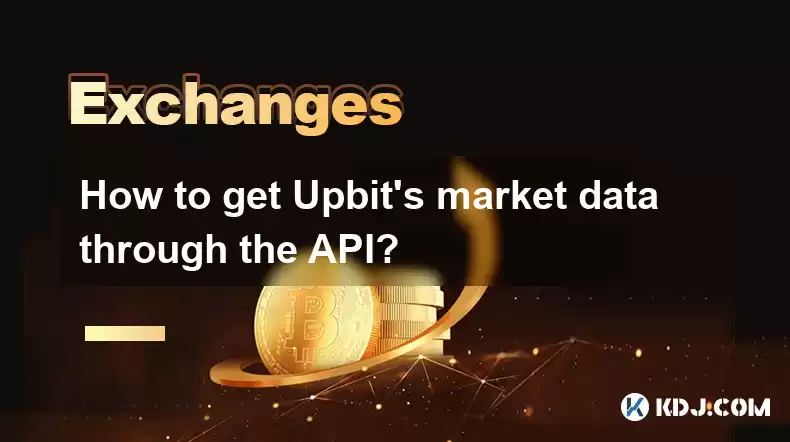-
 bitcoin
bitcoin $87959.907984 USD
1.34% -
 ethereum
ethereum $2920.497338 USD
3.04% -
 tether
tether $0.999775 USD
0.00% -
 xrp
xrp $2.237324 USD
8.12% -
 bnb
bnb $860.243768 USD
0.90% -
 solana
solana $138.089498 USD
5.43% -
 usd-coin
usd-coin $0.999807 USD
0.01% -
 tron
tron $0.272801 USD
-1.53% -
 dogecoin
dogecoin $0.150904 USD
2.96% -
 cardano
cardano $0.421635 USD
1.97% -
 hyperliquid
hyperliquid $32.152445 USD
2.23% -
 bitcoin-cash
bitcoin-cash $533.301069 USD
-1.94% -
 chainlink
chainlink $12.953417 USD
2.68% -
 unus-sed-leo
unus-sed-leo $9.535951 USD
0.73% -
 zcash
zcash $521.483386 USD
-2.87%
How to get Upbit's market data through the API?
To use Upbit's API, set up an API key, understand endpoints like /market/all and /ticker, and handle rate limits for smooth data retrieval.
Apr 12, 2025 at 03:49 am

To access Upbit's market data through their API, understanding the process and tools required can be crucial for developers and traders alike. Upbit, one of South Korea's leading cryptocurrency exchanges, offers a robust API that allows users to retrieve real-time and historical market data. This guide will walk you through the steps to connect to Upbit's API, retrieve market data, and understand the various endpoints available.
Setting Up Your API Key
Before you can start pulling data from Upbit's API, you need to set up an API key. This key will authenticate your requests to the API. Here’s how to do it:
- Visit the Upbit website and log in to your account.
- Navigate to the API Management section. This is usually found under your account settings or a similar area.
- Click on Create New API Key. You will be prompted to enter a name for your key and possibly a description.
- Enable the necessary permissions for your key. For market data, you will typically need read-only access.
- After generating the key, you will receive an API Key and a Secret Key. Keep these secure, as they grant access to your account.
Understanding API Endpoints
Upbit provides several endpoints that cater to different types of market data. Here are the key endpoints you should be familiar with:
- Market Information:
/market/all- This endpoint returns a list of all available markets on Upbit. - Ticker:
/ticker- This endpoint provides real-time ticker data for specified markets. - Candlestick Data:
/candles/minutes/{unit}or/candles/days- These endpoints return candlestick data for specified time intervals. - Orderbook:
/orderbook- This endpoint provides the current orderbook for specified markets. - Trades:
/trades/ticks- This endpoint returns recent trade data for specified markets.
Making API Requests
To make requests to Upbit's API, you will need to use an HTTP client. Here’s how to make a request using Python and the requests library:
Install the
requestslibrary if you haven't already:pip install requestsImport the library and set up your API key:
import requestsapi_key = 'YOUR_API_KEY'secret_key = 'YOUR_SECRET_KEY'
Make a request to the
/market/allendpoint to get a list of all markets:url = 'https://api.upbit.com/v1/market/all'headers = {'Authorization': f'Bearer {api_key}'}response = requests.get(url, headers=headers)markets = response.json()Parse the response to extract the market data:
for market in markets:print(market['market'], market['korean_name'], market['english_name'])
Retrieving Real-Time Ticker Data
To retrieve real-time ticker data, you can use the /ticker endpoint. Here’s how to do it:
Set up the request for the ticker data:
market = 'KRW-BTC' # Example marketurl = f'https://api.upbit.com/v1/ticker?markets={market}'response = requests.get(url, headers=headers)ticker_data = response.json()[0]
Extract and use the ticker data:
print(f'Current price: {ticker_data['trade_price']}')print(f'24-hour volume: {ticker_data['acc_trade_price_24h']}')
Accessing Historical Candlestick Data
For historical data, you can use the candlestick endpoints. Here’s how to retrieve daily candlestick data:
Set up the request for daily candlestick data:
market = 'KRW-BTC' # Example marketurl = f'https://api.upbit.com/v1/candles/days?market={market}&count=10'response = requests.get(url, headers=headers)candles = response.json()Extract and use the candlestick data:
for candle in candles:print(f'Date: {candle['candle_date_time_utc']}, Open: {candle['opening_price']}, High: {candle['high_price']}, Low: {candle['low_price']}, Close: {candle['trade_price']}')
Handling API Rate Limits
Upbit, like many other APIs, has rate limits to prevent abuse. It’s important to handle these limits to ensure your application runs smoothly:
Check the response headers for rate limit information:
remaining = response.headers.get('Remaining-Req')reset_time = response.headers.get('Reset-Time-In-Seconds')print(f'Remaining requests: {remaining}, Reset time: {reset_time}')
Implement a delay in your code if you are approaching the rate limit:
import timeif int(remaining)
time.sleep(int(reset_time) + 1)
FAQs
Q: Can I use Upbit's API for automated trading?A: Yes, Upbit's API supports automated trading through various endpoints that allow you to place orders and manage your trades. However, ensure you have the necessary permissions enabled on your API key.
Q: Is there a limit to the amount of historical data I can retrieve at once?A: Yes, Upbit limits the number of data points you can retrieve in a single request. For example, the candlestick data endpoint allows you to retrieve up to 200 candles per request. You may need to make multiple requests to gather more extensive historical data.
Q: How can I ensure the security of my API key?A: To ensure the security of your API key, never share it with anyone, use it only on secure networks, and consider using environment variables or a secure vault to store your keys instead of hardcoding them in your scripts.
Q: Can I access Upbit's API from any country?A: Upbit's API is primarily designed for users in South Korea, but it can be accessed from other countries. However, some features might be restricted based on your location and the regulations in your country.
Disclaimer:info@kdj.com
The information provided is not trading advice. kdj.com does not assume any responsibility for any investments made based on the information provided in this article. Cryptocurrencies are highly volatile and it is highly recommended that you invest with caution after thorough research!
If you believe that the content used on this website infringes your copyright, please contact us immediately (info@kdj.com) and we will delete it promptly.
- Metaplanet Boosts Bitcoin Holdings, Eyes 210,000 BTC by 2027 Amidst Market Volatility
- 2025-12-25 06:55:01
- Axie Infinity Origins Postseason 15 Unleashes Elite Battles and Festive Flair
- 2025-12-25 07:30:01
- Ethereum Price Test Amidst Significant Whale Buying: Market Shows Subtle Shifts
- 2025-12-25 07:00:01
- Cardano Price Eyes Resistance Breakout as ADA Shows Resilience Amidst Ecosystem Developments
- 2025-12-25 06:55:01
- NYC Alert: Altcoins Eye 1000x Potential in Brewing Crypto Breakout
- 2025-12-25 07:30:01
- The Mt. Gox Ghost Haunts Bitcoin: Accused Hacker's Crypto Cache Comes to Light
- 2025-12-25 07:10:01
Related knowledge

How to trade altcoins on the Bybit spot market?
Dec 25,2025 at 05:39am
Accessing the Bybit Spot Market Interface1. Log in to your Bybit account using verified credentials and two-factor authentication. 2. Navigate to the ...

How to trade with the Bybit Futures Grid Bot?
Dec 25,2025 at 08:19am
Understanding the Bybit Futures Grid Bot Mechanics1. The Bybit Futures Grid Bot operates on perpetual contracts and executes automated buy-low, sell-h...

How to deposit money into Bybit? A guide to fiat and crypto deposits.
Dec 25,2025 at 06:39am
Fiat Deposit Process1. Log in to your Bybit account and navigate to the “Assets” section on the top navigation bar. 2. Click “Deposit” and select “Fia...

What is leverage on Bybit? How to use it safely?
Dec 24,2025 at 07:00am
Understanding Leverage on Bybit1. Leverage on Bybit refers to the ability to control a larger position size using a smaller amount of capital, enabled...

What are the fees for Bybit copy trading? How to calculate profit?
Dec 24,2025 at 05:39pm
Bybit Copy Trading Fee Structure1. Bybit does not charge users a direct fee for initiating or maintaining copy trading positions. The platform allows ...

How to send Bitcoin from Coinbase to a hardware wallet like Ledger?
Dec 24,2025 at 11:40am
Preparing Your Ledger Device1. Ensure your Ledger device is updated to the latest firmware version using Ledger Live. Install the Bitcoin app on your ...

How to trade altcoins on the Bybit spot market?
Dec 25,2025 at 05:39am
Accessing the Bybit Spot Market Interface1. Log in to your Bybit account using verified credentials and two-factor authentication. 2. Navigate to the ...

How to trade with the Bybit Futures Grid Bot?
Dec 25,2025 at 08:19am
Understanding the Bybit Futures Grid Bot Mechanics1. The Bybit Futures Grid Bot operates on perpetual contracts and executes automated buy-low, sell-h...

How to deposit money into Bybit? A guide to fiat and crypto deposits.
Dec 25,2025 at 06:39am
Fiat Deposit Process1. Log in to your Bybit account and navigate to the “Assets” section on the top navigation bar. 2. Click “Deposit” and select “Fia...

What is leverage on Bybit? How to use it safely?
Dec 24,2025 at 07:00am
Understanding Leverage on Bybit1. Leverage on Bybit refers to the ability to control a larger position size using a smaller amount of capital, enabled...

What are the fees for Bybit copy trading? How to calculate profit?
Dec 24,2025 at 05:39pm
Bybit Copy Trading Fee Structure1. Bybit does not charge users a direct fee for initiating or maintaining copy trading positions. The platform allows ...

How to send Bitcoin from Coinbase to a hardware wallet like Ledger?
Dec 24,2025 at 11:40am
Preparing Your Ledger Device1. Ensure your Ledger device is updated to the latest firmware version using Ledger Live. Install the Bitcoin app on your ...
See all articles










































































